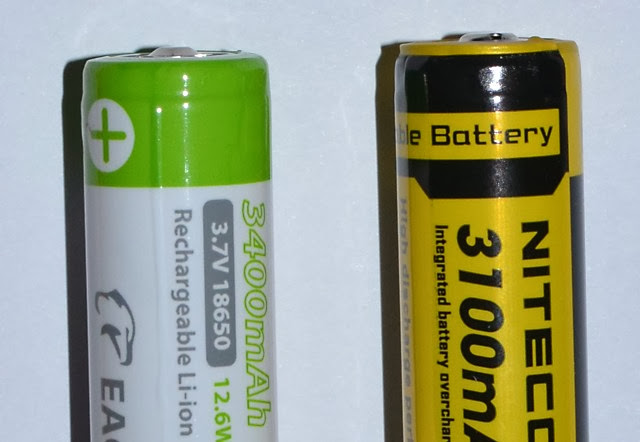Warning: pic heavy, as usual. 
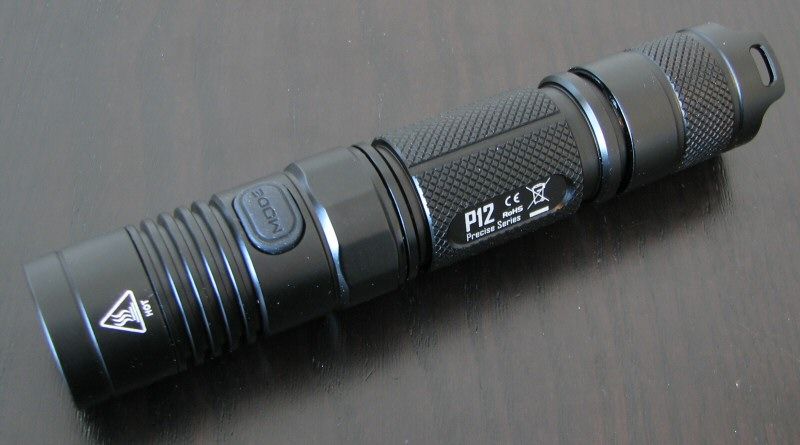
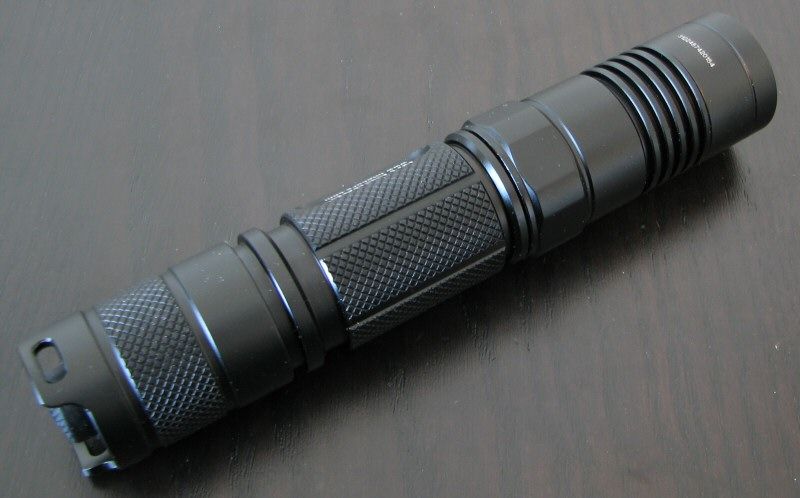
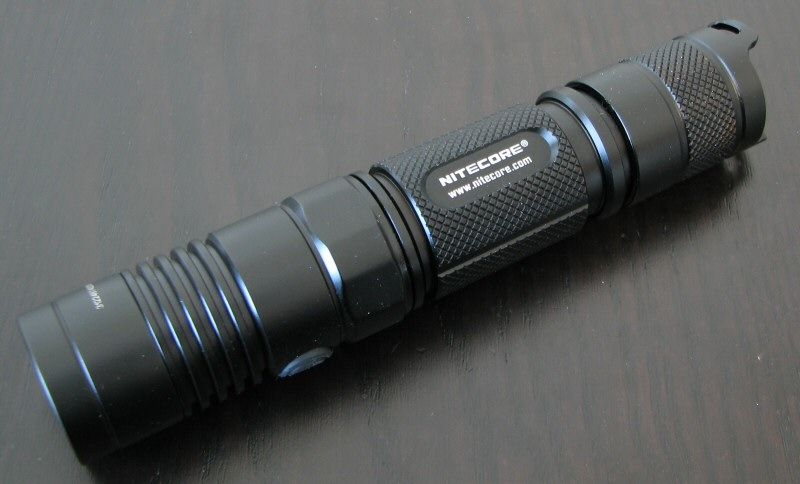
Nitecore has sent me their new compact 1x18650/2xCR123A model – the P12 (XM-L2). The P12 features a dual-switch interface, which has become popular in recent years with a lot of manufacturers. Let's see how the P12 model compares to the competition. :wave:
For additional general comments on how several of the current dual-switch lights in this battery class compare, please see my post #2.
Manufacturer Reported Specifications:
(note: as always, these are simply what the manufacturer provides – scroll down to see my actual testing results).
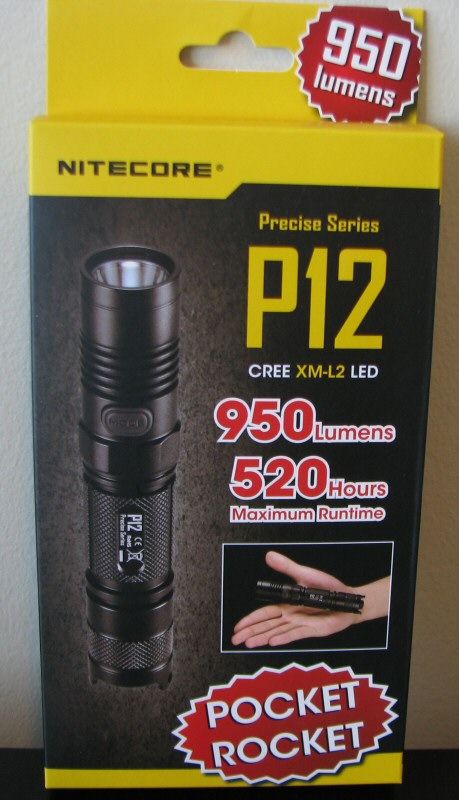
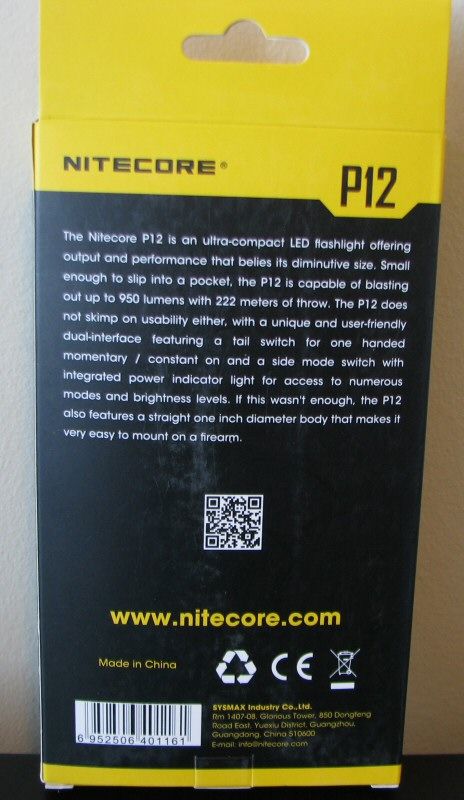

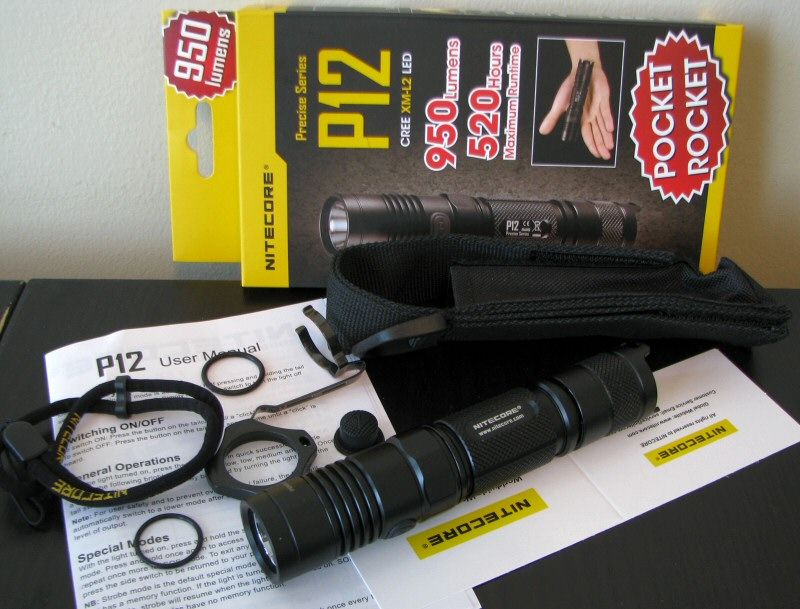
Packaging is Nirecore's current standard thin cardboard display box, with detailed specs and information printed right on the box. Inside, included with the light are spare O-rings, spare tailswitch boot cover, removable grip ring, pocket clip, basic wrist lanyard, holster with Velcro closing flap, product inserts, warranty card, and manual.
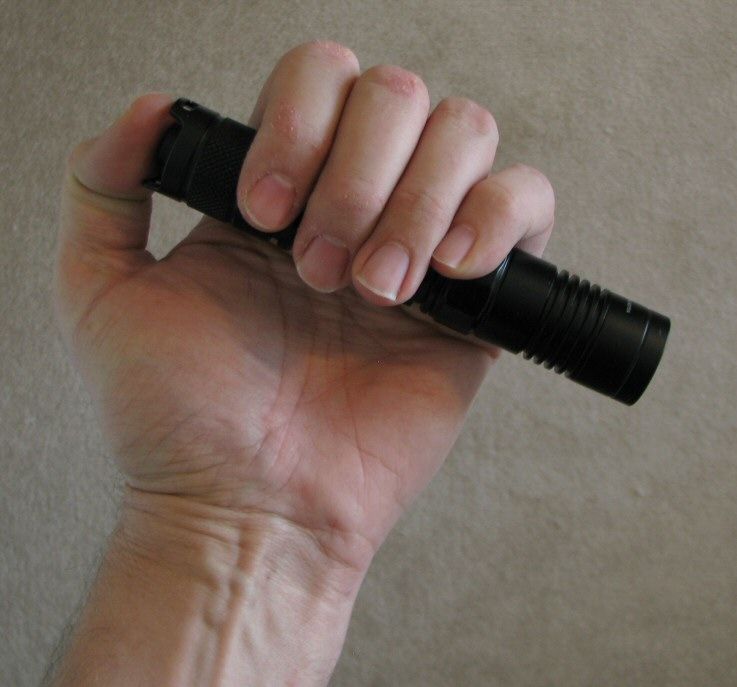
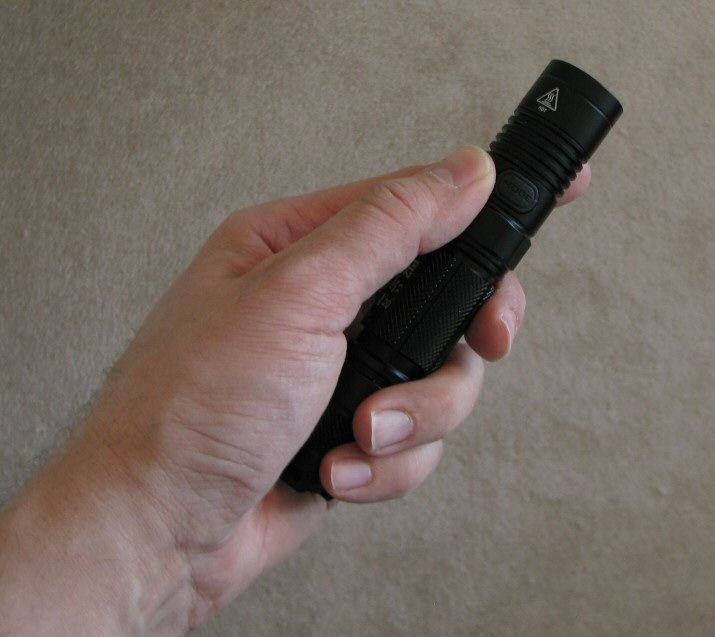
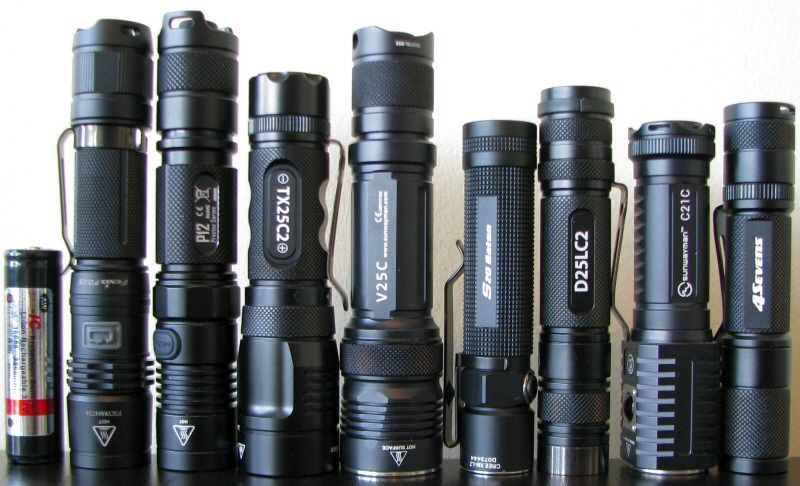
From left to right: AW Protected 18650 2200mAh; Fenix PD35; Nitecore P12; Eagletac TX25C2; Sunwayman V25C; Olight S20 2014; Eagletac D25LC2; Sunwayman C21C; Foursevens Quark Q123-2.
All dimensions directly measured, and given with no batteries installed:
Nitecore P12: Weight: 89.7g, Length: 139.4mm, Width (bezel): 25.4mm
Eagletac D25LC2: Weight: 50.0g, Length: 116.3mm, Width (bezel): 22.5mm
Eagletac TX25C2: Weight 93.6g, Length: 120.4mm, Width (bezel): 31.6mm
Fenix PD35: Weight: 82.7g, Length: 138.1mm, Width (bezel): 25.4mm
Foursevens MMR-X: Weight 90.8g, Weight (with 18650): 138.5g, Length: 138.6mm, Width (bezel): 31.5mm
Foursevens MMX Burst: Weight 145.8g, Length: 153.3mm, Width (bezel): 38.7mm
Olight M20S-X: Weight: 124.1g, Length: 145.4mm, Width: 35.5mm (head)
Thrunite TN12-2014: Weight: 80.0g, Length: 140.5mm, Width (bezel): 25.4mm
Zebralight SC600 II: Weight 79.3g, Length: 101.8mm, Width (bezel) 29.7mm
The P12 is certainly well in keeping with other recent dual-switch designs.
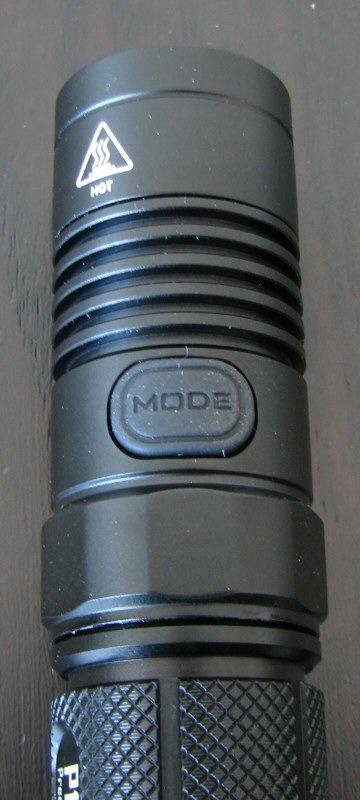
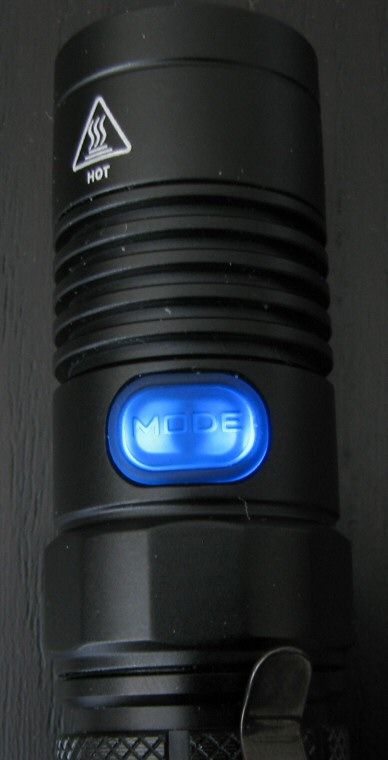
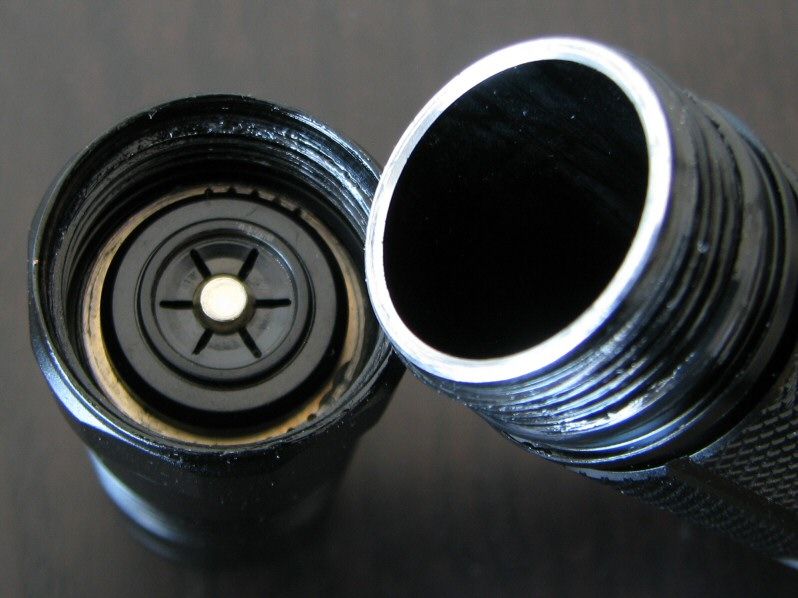
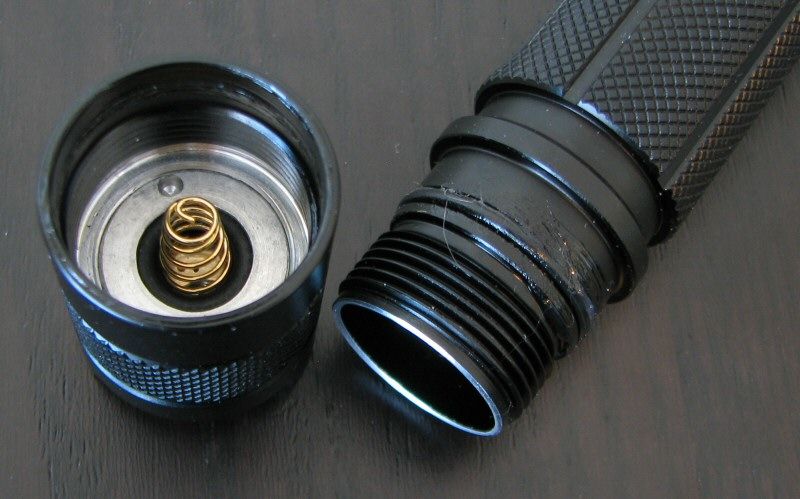
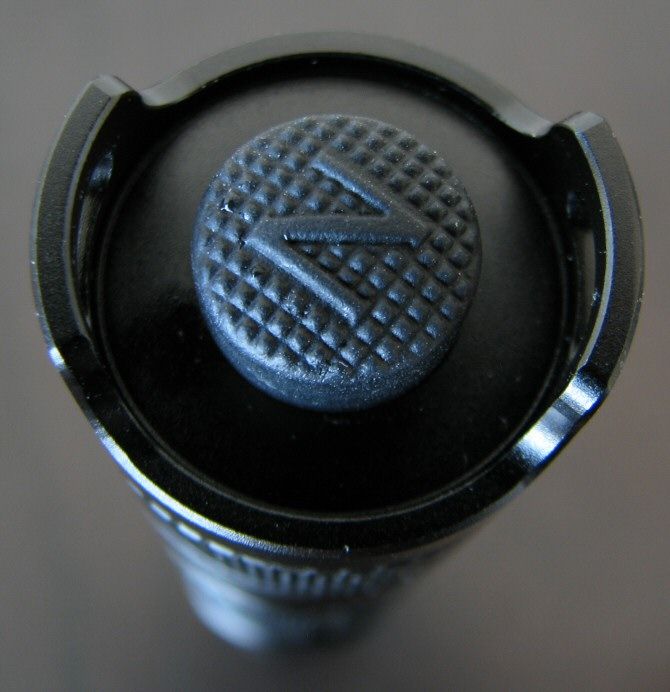
The P12 is a compact, yet solid little light. Anodizing is a shiny black finish, hard anodized, with no chips or damage on my sample. Body labels are bright white and clear against the black background. Knurling is of moderate aggressiveness on the body tube and tailcap. But when combined all the other grip elements (e.g., side switch cover, fins in the head, pocket clip, etc.), I would describe overall grip as very good.
The light has decent anti-roll indentations on the body, but the clip is even more helpful in that regard. Clip is supposedly titanium-plated stainless steel, and feels reasonably sturdy. There is also a bundled grip ring in the package, for cigar-grip style carry (also very effective for anti-roll).
Tailcap screw threads are standard triangular cut and anodized for lock-out at either end of the body tube. :thumbsup:
The P12 uses a forward clicky switch, but with very good tailstanding ability due to the raised side edges (suitable for lanyard attachement). Switch access by finger or thumb is good.
On/off is controlled by the physical tailcap clicky switch, but all mode switching is done by the electronic side switch in the head. The mode-changing switch in the head has pretty good feel for an electronic switch, with typical traverse. It is relatively easy to locate by feel (although could be grippier, with more visual distinctiveness).
Note that like many other Nitecore models, there is a blue LED under the mode-changing side-switch that will glow blue when the batteries are running low. It also serves as a voltage read-out function. Please see my User Interface section for a discussion.
There is a physical reverse polarity feature in the head. However, this has been updated from earlier Nitecore models and now allows "wide button top" cells to work in the light. True flat-tops (where the positive contact is below the wrapper) won't work, but all my cells with a slightly raised contact worked fine.
The body tube is wide enough to accommodate all size 18650 cells, and there seems to be plenty of room of longer cells as well.
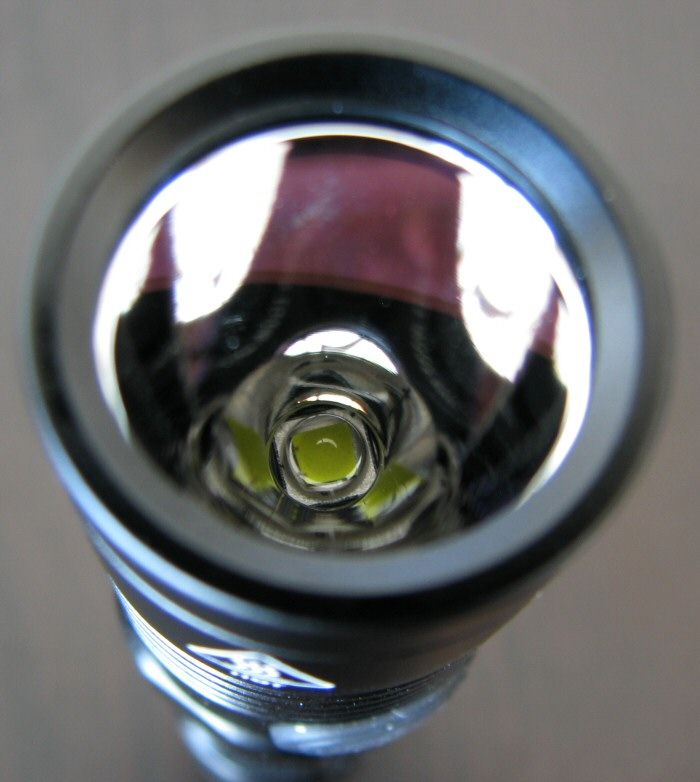
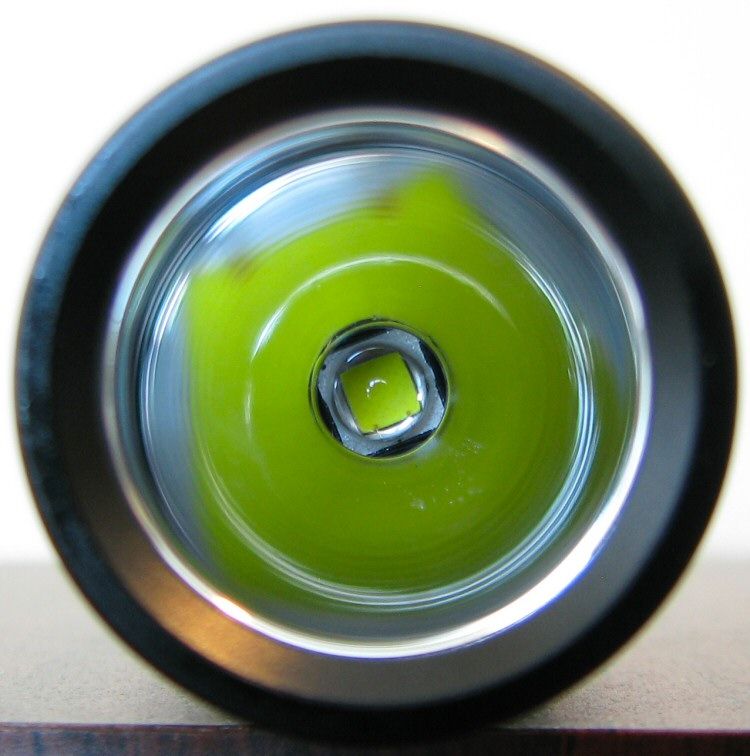
The P12 comes with a flat black aluminum bezel. The overall head is typical for this class - not very large. Reflector is smooth, and fairly deep given this size head. Coupled with the XM-L2 cool white emitter (which was well centered on my sample), I would expect a fairly typical beam pattern, but with slightly greater throw than many in this class. Scroll down for beamshots.
Nitecore also sent me one of their own-brand 18650 cells to test:
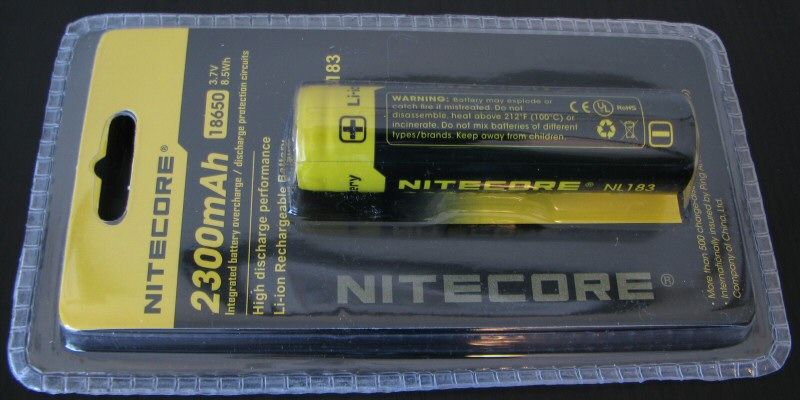
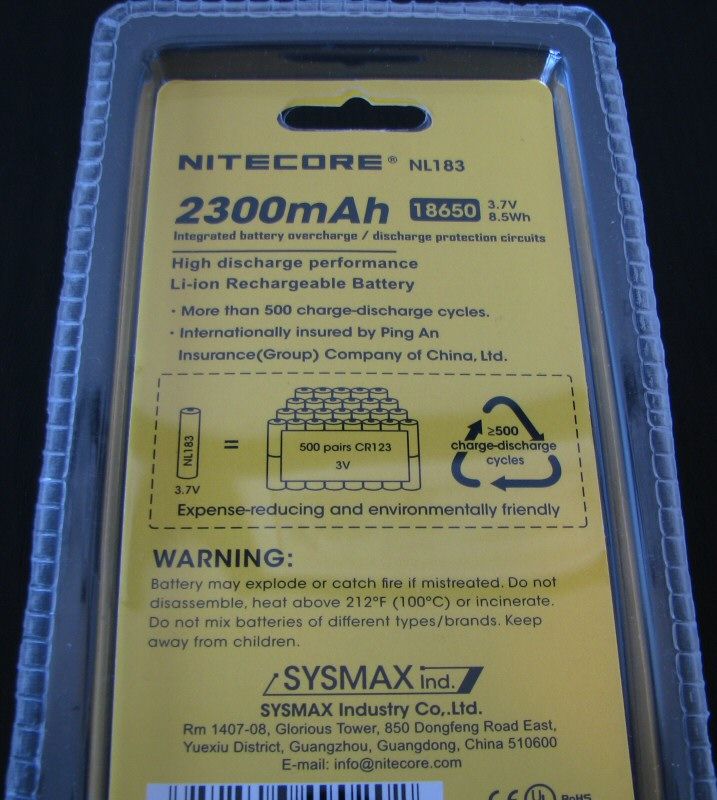
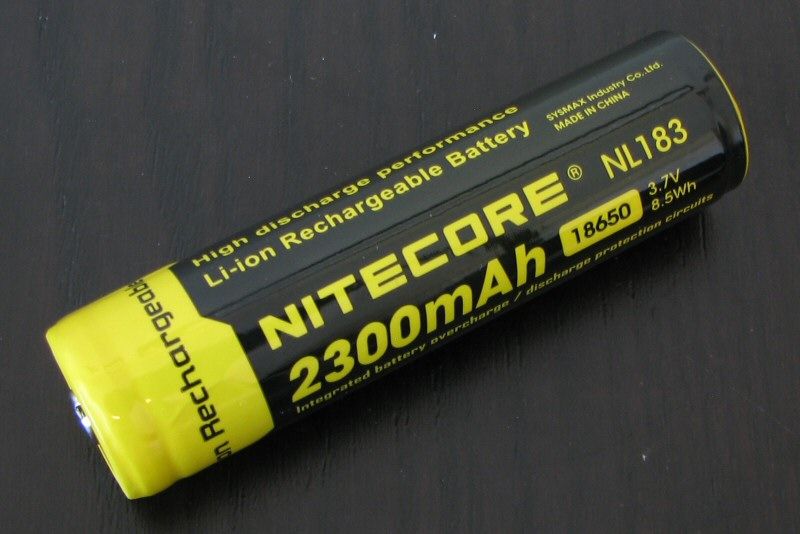
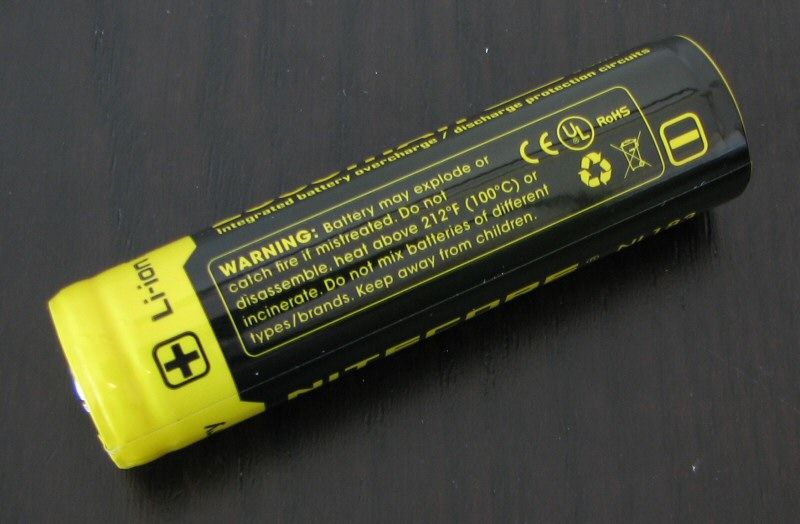
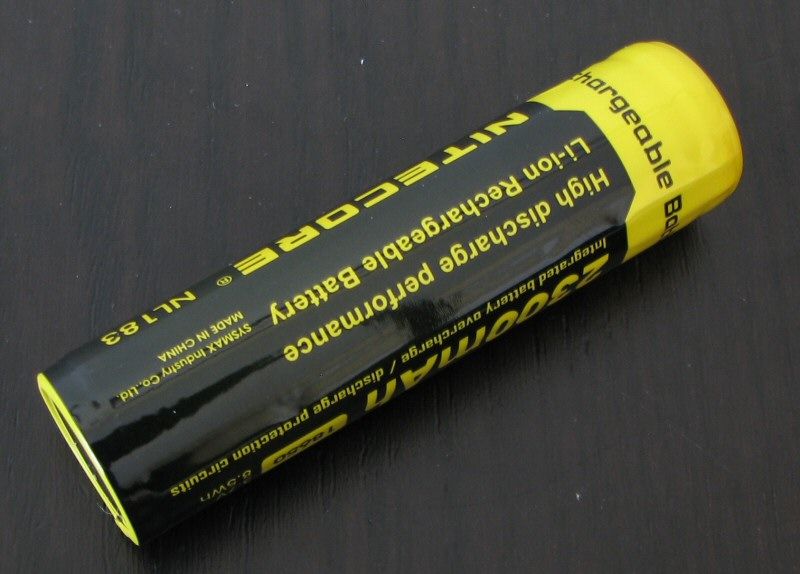
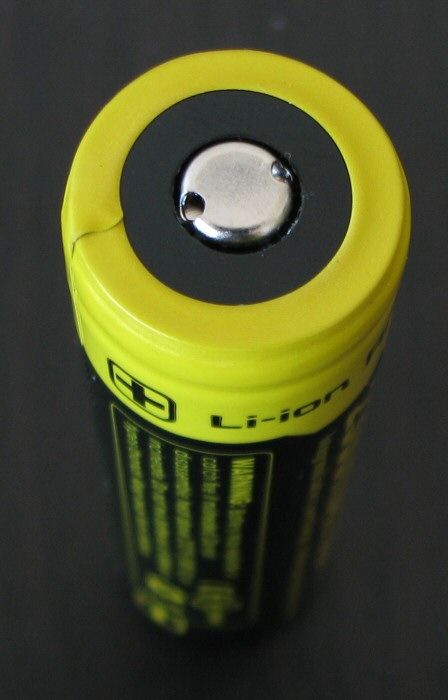
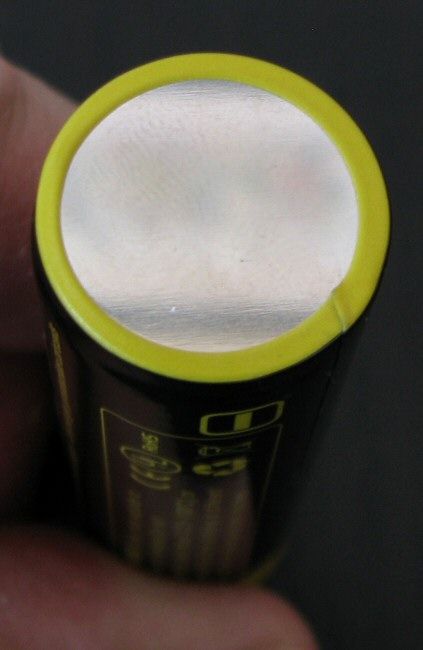
As you can see, the rated capacity for this protected 18650 is 2300mAh. I will include additional runtimes comparing it to my standard AW protected 2200mAh cells.
User Interface
The P12 uses a dual-switch interface, similar to the Fenix PD35 or Thrunite TN12-2014.
Turn the light on/off by the forward tailcap switch. Lightly press and hold for momentary, click (press and release) for constant on. Click again to turn off.
To change modes, click the electronic switch in the head, while the light on. Mode sequence is Lower > Lo > Med > Hi, in repeating sequence. The light has mode memory, and returns the last level set after turning the tail switch off/on.
Press and hold the electronic switch to access a tactical Strobe mode. Press and hold again to select the next blinking mode. Mode sequence is: Strobe > Locator Beacon > SOS, in a repeating loop. A single click exits you from the blinking modes and puts you back into constant output.
Note that there is mode memory for the Strobe mode (but not the other two blinking modes). This is convenient if you are someone who likes immediate access to Strobe from Off.
The P12 also has a blue LED under the side mode-changing switch to serve as a low voltage indicator when the flashlight is On. Once the cells are below 50% power (according to Nitecore), this indicator will flash blue every 2 seconds. It will flash faster as the power capacity drops down further.
With the light turned Off, you can get a battery voltage readout by pressing and holding the side switch while simultaneously activating the tailcap switch. The blue LED will then read out the voltage in a series of flashes (e.g., Four flashes, followed by a short pause, with two more flashes would indicate a full charge of 4.2V). Note that if you click the tailswitch on (as opposed to press-hold), the light will actually turn itself on after the voltage read-out finishes.
Video:
For information on the light, including the build and user interface, please see my video overview:
Video was recorded in 720p, but YouTube typically defaults to 360p. Once the video is running, you can click on the configuration settings icon and select the higher 480p to 720p options. You can also run full-screen.
As with all my videos, I recommend you have annotations turned on. I commonly update the commentary with additional information or clarifications before publicly releasing the video.
PWM/Strobe
The P12 is fully current-controlled. There is no PWM, on any level.
I did detect some circuit noise on my oscilloscope at the Lo and Med levels, but this was completely invisible in actual use.
Med Noise (two separate timescales):
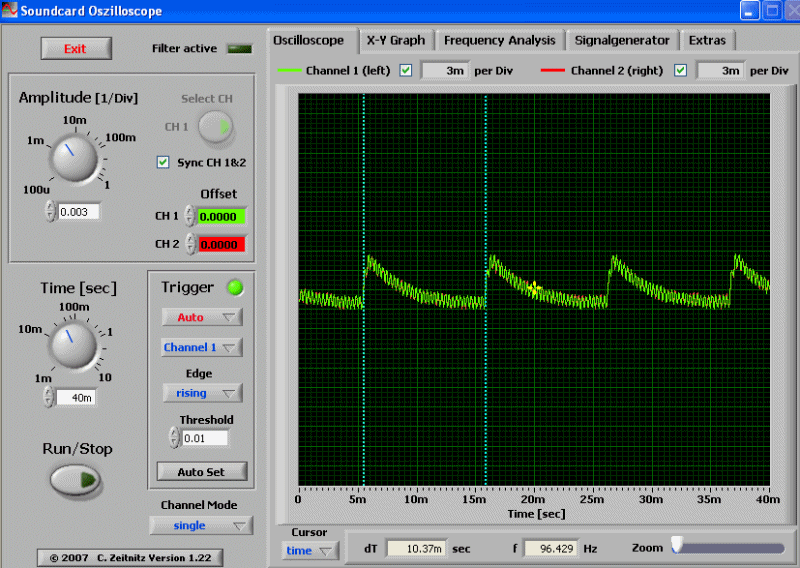
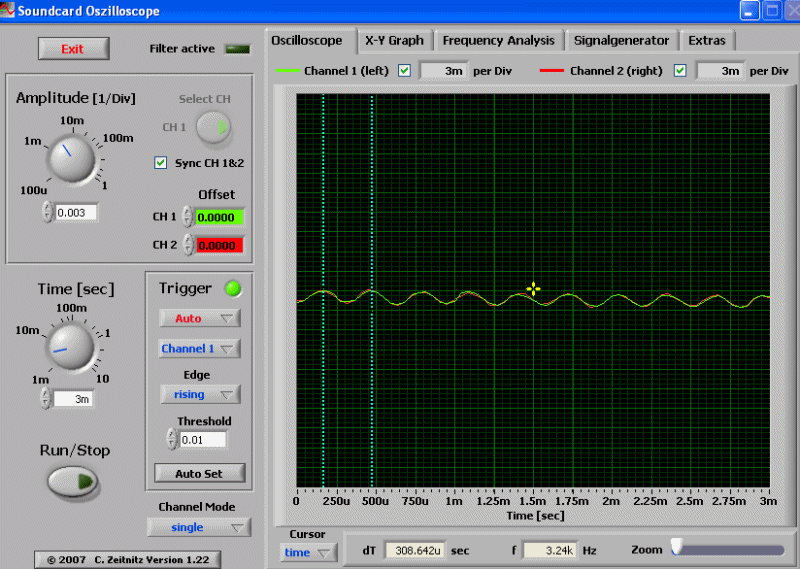
Again, consistent with my standard review policy, I report on any oscilloscope signals that I can detect in the output of a light. But I can assure you that the above patterns produce no visible effect – even when shining on a fan. The P12 is fully "flicker-free" at all levels.
Strobe
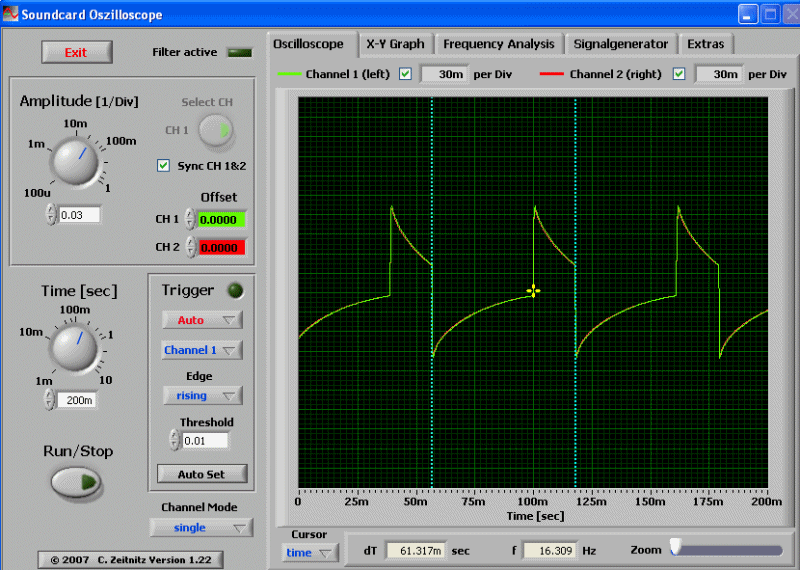
The strobe was a very fast "tactical" strobe, of 16.3Hz frequency. Strobe duty cycle is a little unusual, as it is only "on" a portion of the total time of each strobe cycle (i.e., most strobes are an even 50:50 on/off). But it doesn't change how disorienting it is in general terms. :green:
Beacon
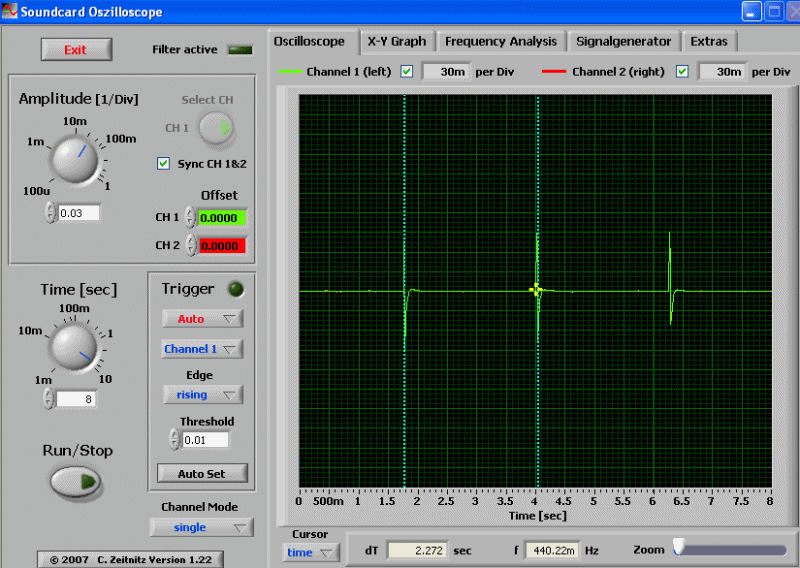
Beacon was a quick high-output flash, once every 2.2 secs or so.
SOS
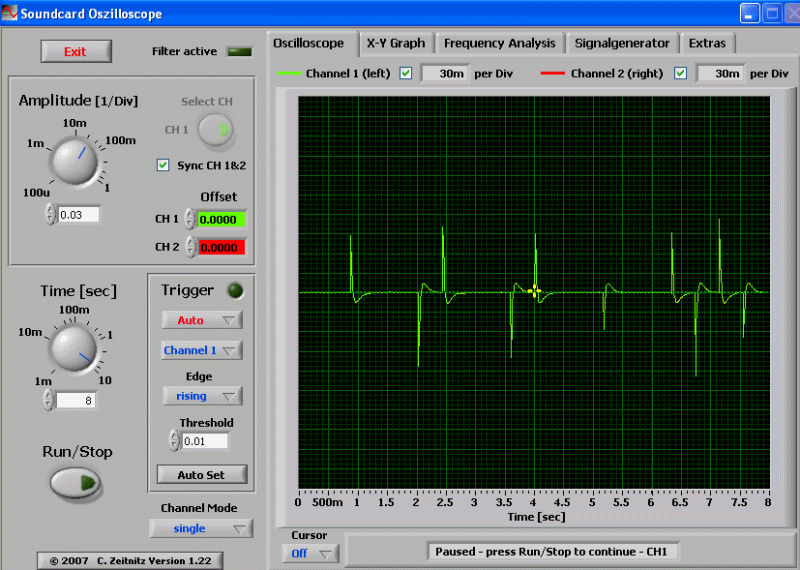
SOS was a fairly typical SOS mode.
Beamshots:
For white-wall beamshots below, all lights are on Max output on an AW protected 18650 battery. Lights are about ~0.75 meter from a white wall (with the camera ~1.25 meters back from the wall). Automatic white balance on the camera, to minimize tint differences.
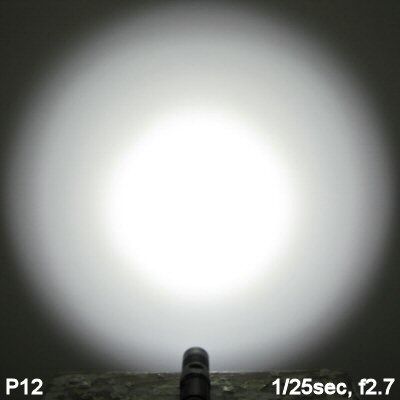
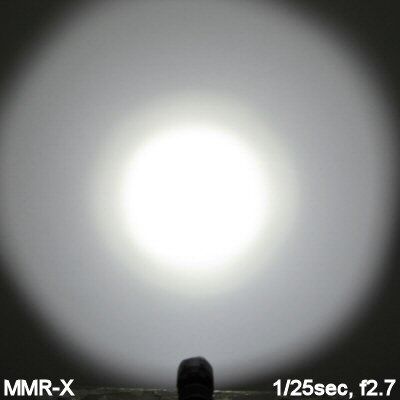
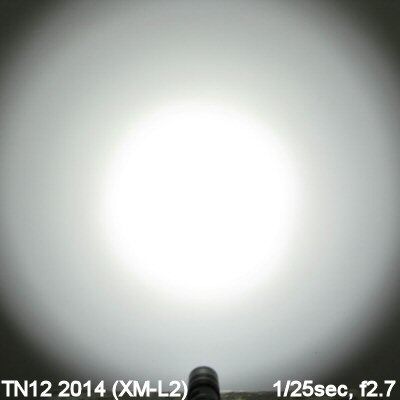
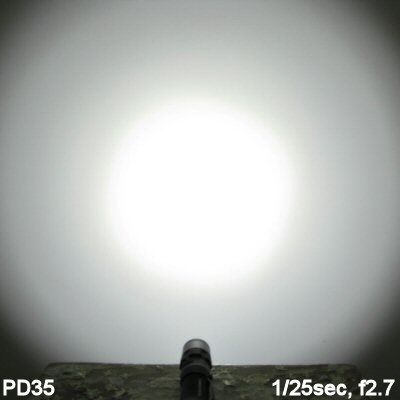
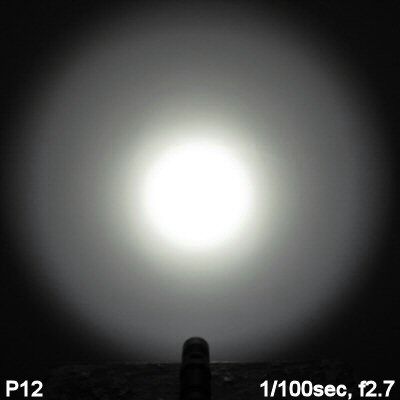
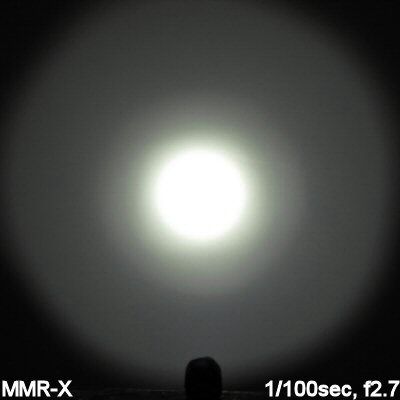
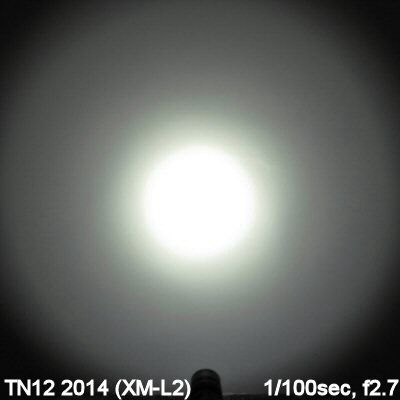
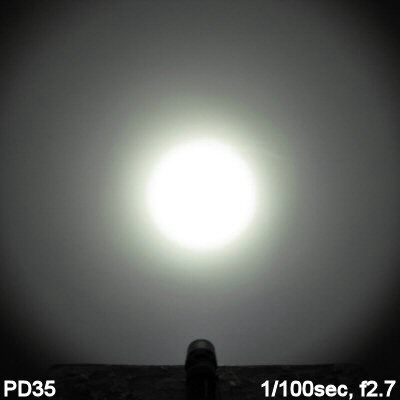
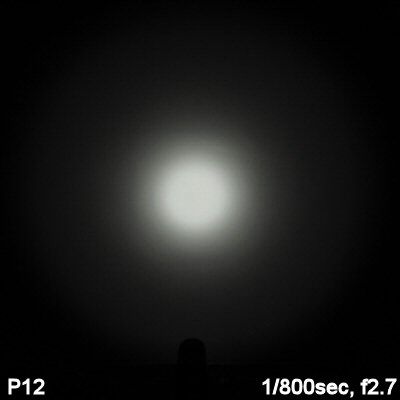
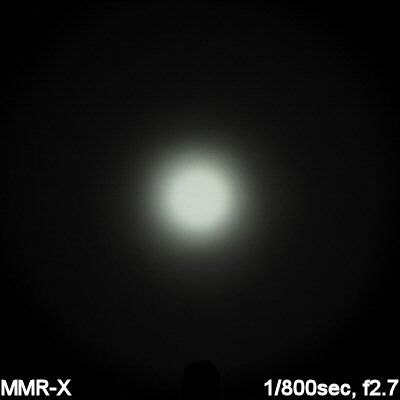
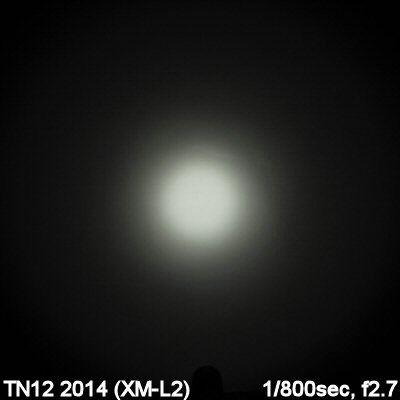
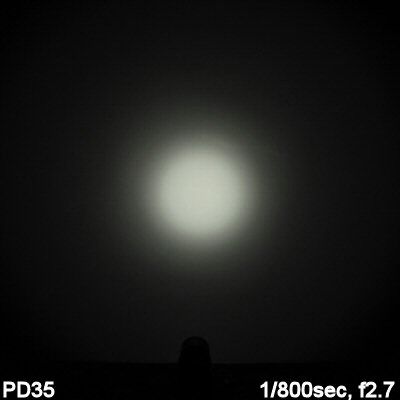
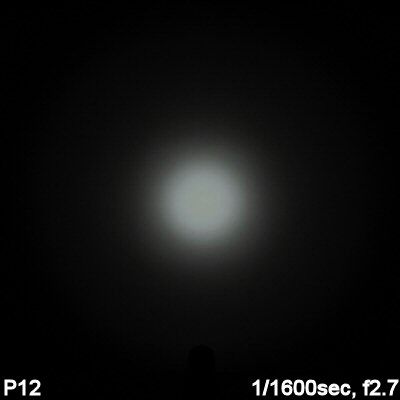
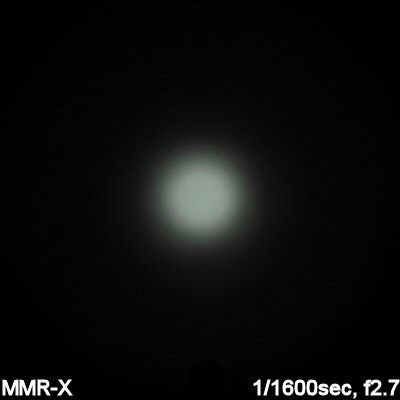
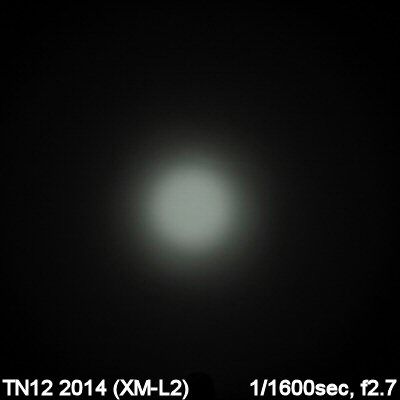
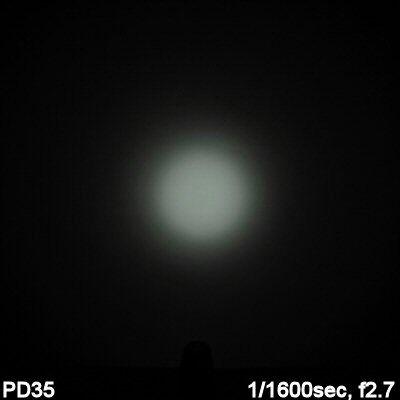
Beam pattern is about what you would expect for a light this size. Spillbeam width is slightly narrower than some recent competitors, and the P12 has excellent throw for the class (both consistent with its somewhat deeper reflector). Scroll down for detailed output and throw measures.
Testing Method:
All my output numbers are relative for my home-made light box setup, as described on my flashlightreviews.ca website. You can directly compare all my relative output values from different reviews - i.e. an output value of "10" in one graph is the same as "10" in another. All runtimes are done under a cooling fan, except for any extended run Lo/Min modes (i.e. >12 hours) which are done without cooling.
I have devised a method for converting my lightbox relative output values (ROV) to estimated Lumens. See my How to convert Selfbuilt's Lightbox values to Lumens thread for more info.
Throw/Output Summary Chart:
My summary tables are reported in a manner consistent with the ANSI FL-1 standard for flashlight testing. Please see http://www.flashlightreviews.ca/FL1.htm for a discussion, and a description of all the terms used in these tables. Effective July 2012, I have updated all my Peak Intensity/Beam Distance measures with a NIST-certified Extech EA31 lightmeter (orange highlights).
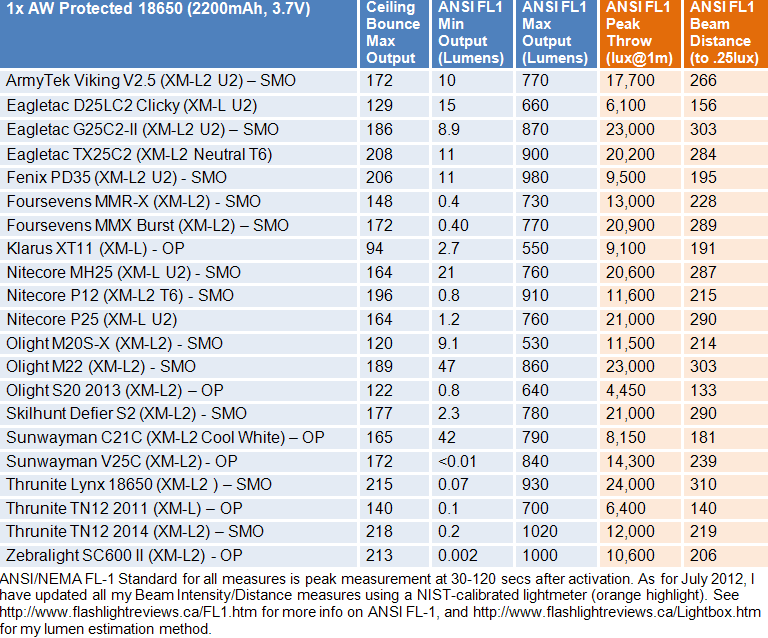
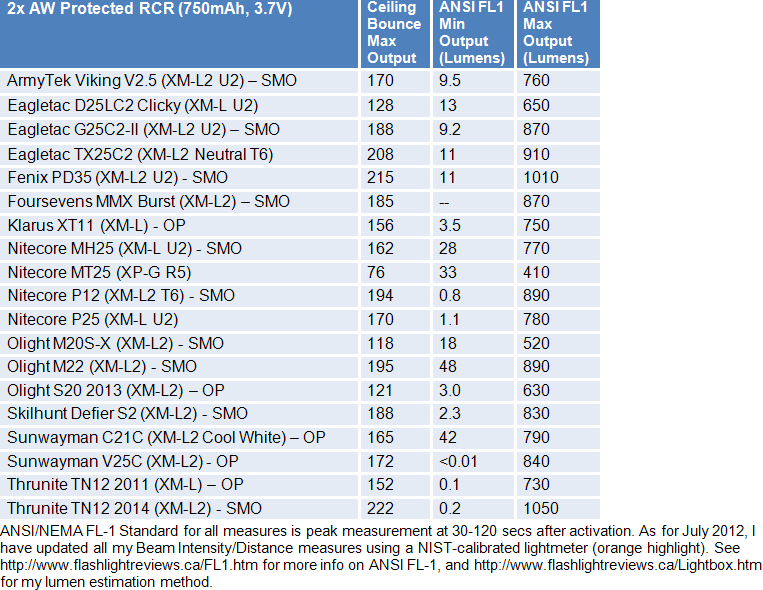
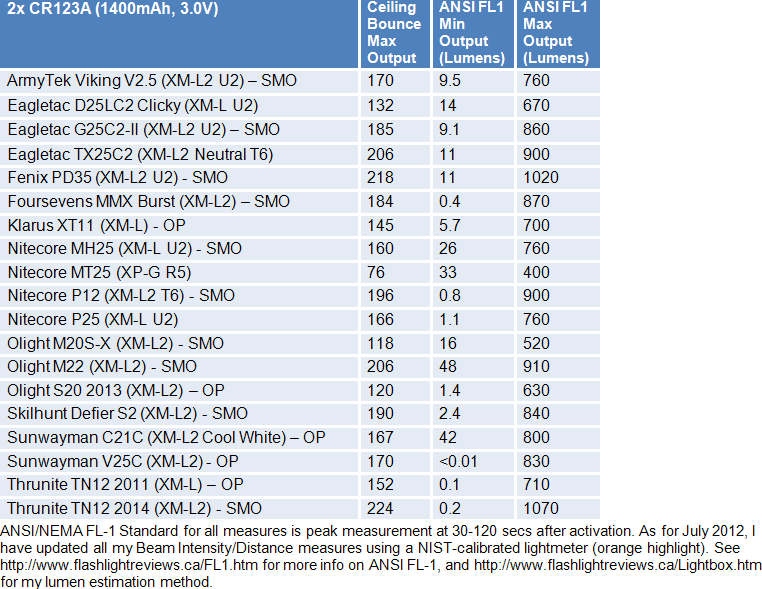
The P12 is a heavily-driven light for this class. Max output is similar across all supported battery types. It also has a consistent <1 lumen "Lower" mode, which is appreciated.
Throw is quite reasonable for the class, given the size of the head and reflector.
Let's see how all the levels compare to the official specs, on 1x18650 in my lightbox:
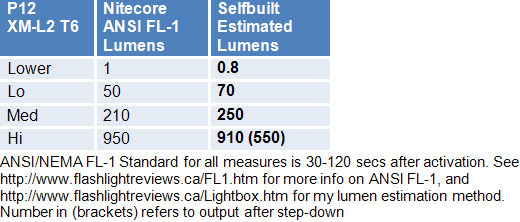
There is a generally good concordance between my estimated lumens and Nitecore's published specs. Note that the Hi mode of the P12 steps down to an intermediate Hi level (i.e., something between the defined Med and Hi modes). See my Runtimes below for more info. And as always, you have to consider my estimated lumens as a source of relative measures between lights (i.e., not to be taken as absolute values).
Note that the Hi mode of the P12 steps down to an intermediate Hi level (i.e., something between the defined Med and Hi modes). See my Runtimes below for more info. And as always, you have to consider my estimated lumens as a source of relative measures between lights (i.e., not to be taken as absolute values).
I am glad to see the <1 lumen "Lower" mode on the P12, as I personally like having low-level options in a general purpose light. This is very helpful when you have dark adapted eyes. The mode spacing is pretty good, although most lights of this this class would typically have an additional Hi level between the current Med and Hi outputs.
Output/Runtime Graphs:
For all these comparisons, I will use the standard Nitecore terminology for the modes (i.e., "Hi" is in fact max output).
To start, here is a comparison of four of my highest output recent lights in this class; the Zebralight SC600-II, Fenix PD35, Nitecore P12, and Thrunite TN12-2014:
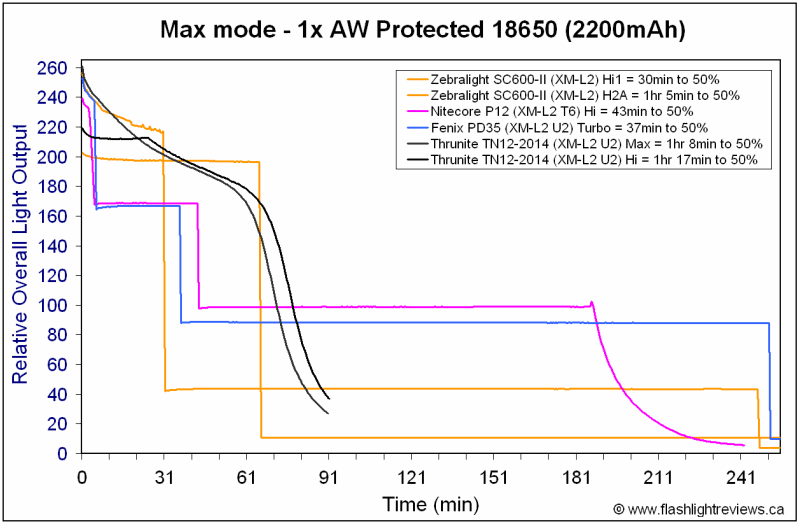
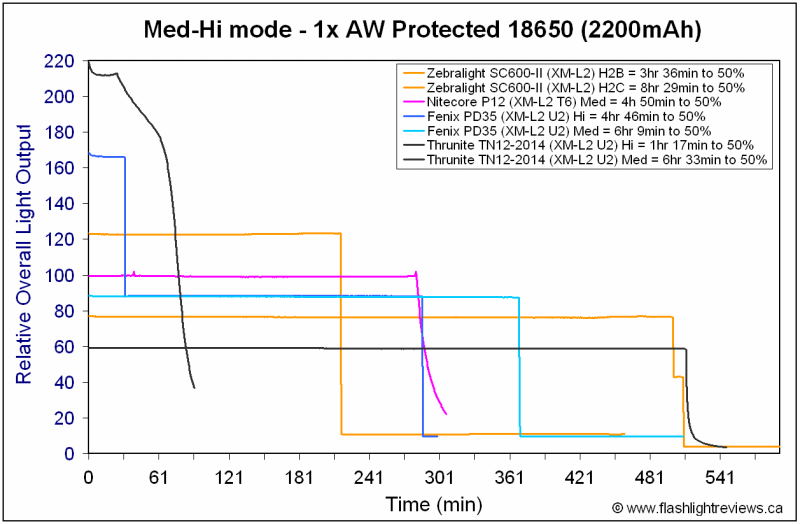
Given the incredibly high drive level of these lights on Max, it is not surprising that all of them either show a direct-drive-like pattern (i.e., the TN12-2014), or have a defined step-down (either timed or thermal-managed). It just isn't possible for these small lights to maintain that sort of output (and heat) on a single 18650 in a fully regulated fashion for long. The Fenix PD35 and Nitecore P12 have a very similar pattern of gradual step-downs from Max, with at least the first step timed.
The P12 shows very good efficiency and regulation at all levels, although it is nudged out of the top efficiency spot for this class by the PD35 and SC600-II. As mentioned above, I would like to see the first step down from Max be used as an additional defined Med-Hi mode on the P12 (i.e., a five-level light, instead of a four-level one).
Let's see how it does on 1x18650 against a wider range of lights (omitting the comparisons already shown above). For this comparison, I have added a Max mode runtime with the supplied Nitecore 2300mAh battery on the P12.
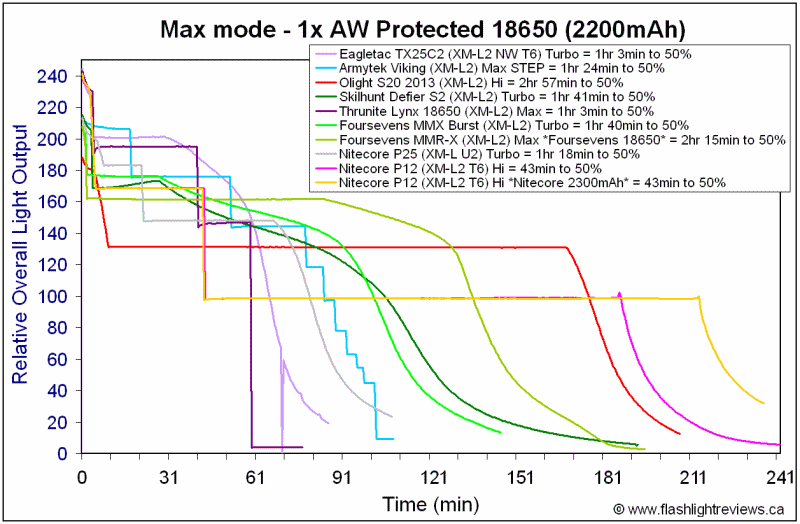
The Nitecore 2300mAh battery gives a little bit of extra max runtime compared to my AW 2200mAh – but doesn't affect the timing of the first two step-downs (hard to see above, because the pink and light orange lines overlap until the just before end). This is as I would expect – higher capacity cells typically only affect runtime at the far right of the time scale.
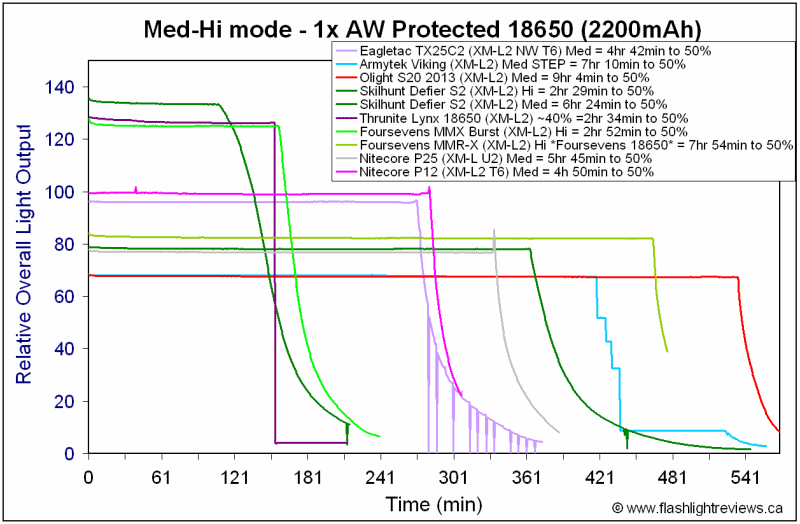
Overall efficiency of P12 remains very good for this class (e.g., similar to my Eagletac TX25C2 in the Med mode run)
Here are a couple of comparisons on 2x battery sources:
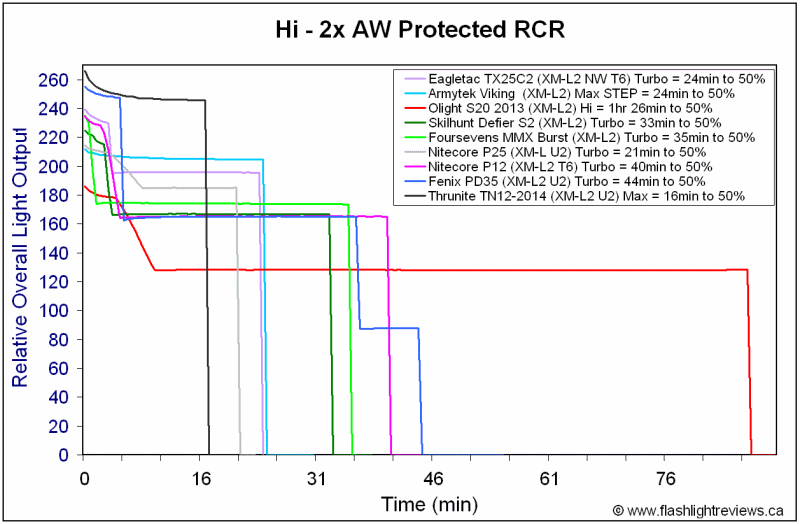
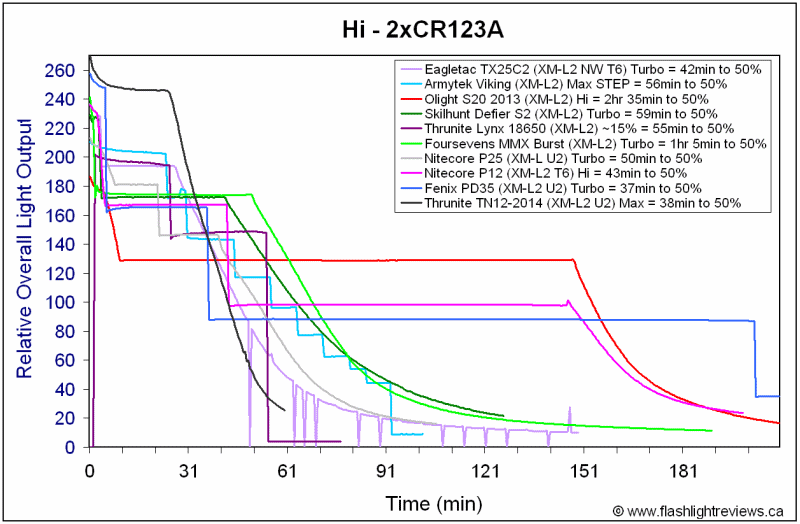
Thanks to the set of step-downs on Hi, you can safely run 2xCR123A or 2xRCR cells in this light.
Potential Issues
There are a series of step-downs from "Hi" (aka max) on the P12, on all batteries (i.e., rapid step-down initially from Hi, and then a subsequent step down to Med).
The P12 lacks a typical "Hi" mode (i.e., the P12 "Hi" mode is basically Turbo, with no lower "Hi" mode, as on most lights). I would think adding the step-down Hi level into the regular sequence would be good idea (i.e. as a fifth selectable mode).
Preliminary Observations
The P12 is a nice addition to the Nitecore line-up. Although superficially similar to a number of other dual-switch 1x18650, 2xCR123A/RCR lights, there are some clear indications of Nitecore's "DNA" incorporated here.
Build quality is very good, with good hand feel and overall design. I like the easy access to the tailswitch, while maintaining tailstanding – one of the best I've seen in this class. The user interface is very intuitive, with the dual physical tailcap switch and side mode-changing electronic switch. Switch feel is good on both. And the low-voltage and battery read-out features of side switch (using Nitecore's trademark blue LED) are nice additions to this class.
In terms of output modes, the P12 has a good range of constant modes - although one extra intermediate Med-Hi mode would have been nice (i.e., something like the Hi step-down level). I particularly like the <1 lumen "lower" level here - helpful if you have dark-adapted eyes. Nitecore has provided additional blinking modes, compared to most of the competition in this class. I personally like the Beacon mode, but would still like to see a slow signaling strobe. And for those of you who demand such things, there is mode memory for the Tactical Strobe mode here (i.e., you can set the P12 to come on that way).
Output/runtime efficiency was very good, demonstrating a good constant-current circuit. The step-down pattern on Turbo was remarkably similar to the Fenix PD35. The light is fully regulated at all levels.
Beam pattern is good as well, with a nice balance between throw and spill. Given the fairly standard size head, there are lots of beam shaping accessories out there from a range of makers that will fit on the light.
At the end of the day, there is a lot to here to commend the P12 for the price. More than just a "me-too" light, the P12 has some definite additions to this class (i.e., extra blinky modes, mode memory for tactical strobe, low-voltage indicator and battery read out). Definitely a strong contender in the class, and one well worth considering. :wave:
More than just a "me-too" light, the P12 has some definite additions to this class (i.e., extra blinky modes, mode memory for tactical strobe, low-voltage indicator and battery read out). Definitely a strong contender in the class, and one well worth considering. :wave:
P.S.: I know a lot people are wondering how the Fenix PD35, Nitecore P12 and Thrunite TN12-2014 directly compare to each other. In addition to all the objectives measures included in this review, I've added some general comparison comments in post #2.
-----
P12 provided by Nitecore for review.



Nitecore has sent me their new compact 1x18650/2xCR123A model – the P12 (XM-L2). The P12 features a dual-switch interface, which has become popular in recent years with a lot of manufacturers. Let's see how the P12 model compares to the competition. :wave:
For additional general comments on how several of the current dual-switch lights in this battery class compare, please see my post #2.
Manufacturer Reported Specifications:
(note: as always, these are simply what the manufacturer provides – scroll down to see my actual testing results).
- LED: Cree XM-L2 T6
- Max Lumen: 950
- Uses one 18650 rechargeable battery or two CR123A batteries.
- Output/Runtime (1x18650): Hi 950lumens / 1hr 15min – Med 210lumens / 6hr – Lo 50lumens / 28hr – Lower 1lumen / 520hr
- Output/Runtime (2xCR123A): Hi 950lumens / 1hhr – Med 210lumens / 5hr 15min – Lo 50lumens / 20hr – Lower 1lumen / 300hr
- Beam Intensity: 12,450cd
- Beam Distance: 222m
- Impact resistant to 1.5 meters
- Waterproof in accordance with IPX-8 (two meters submersible)
- Second generation 'Crystal Coating Technology' combined with 'Precision Digital Optics Technology' provide extreme reflector performance
- High efficiency circuit board provides up to 520 hours runtime on low
- Side switch interface provides one-handed operation and easy access to all functions
- Side switch features an indicator light which displays remain ing battery power (patented)
- Power indicator secondary function displays battery voltage (accurate to 0.1V)
- Intelligent memory function stores preferred brightness setting
- High-efficiency regulation circuit provides unwavering output
- Toughened ultra-clear mineral glass with anti-reflective coating
- Constructed from aero grade aluminium alloy with HAIII military grade hard-anodized finish
- Stainless steel titanium-plated clip included
- Tail stand capability
- Dimensions: Length: 139mm (5.47"), Head Diameter: 25.4mm (1"), Tail Diameter: 25.4mm (1")
- Weight: 88grams (3.10oz)(without battery)
- Accessories: Quality holster, clip, tactical ring, lanyard, spare tail cap, spare O-ring
- MSRP: ~$60




Packaging is Nirecore's current standard thin cardboard display box, with detailed specs and information printed right on the box. Inside, included with the light are spare O-rings, spare tailswitch boot cover, removable grip ring, pocket clip, basic wrist lanyard, holster with Velcro closing flap, product inserts, warranty card, and manual.



From left to right: AW Protected 18650 2200mAh; Fenix PD35; Nitecore P12; Eagletac TX25C2; Sunwayman V25C; Olight S20 2014; Eagletac D25LC2; Sunwayman C21C; Foursevens Quark Q123-2.
All dimensions directly measured, and given with no batteries installed:
Nitecore P12: Weight: 89.7g, Length: 139.4mm, Width (bezel): 25.4mm
Eagletac D25LC2: Weight: 50.0g, Length: 116.3mm, Width (bezel): 22.5mm
Eagletac TX25C2: Weight 93.6g, Length: 120.4mm, Width (bezel): 31.6mm
Fenix PD35: Weight: 82.7g, Length: 138.1mm, Width (bezel): 25.4mm
Foursevens MMR-X: Weight 90.8g, Weight (with 18650): 138.5g, Length: 138.6mm, Width (bezel): 31.5mm
Foursevens MMX Burst: Weight 145.8g, Length: 153.3mm, Width (bezel): 38.7mm
Olight M20S-X: Weight: 124.1g, Length: 145.4mm, Width: 35.5mm (head)
Thrunite TN12-2014: Weight: 80.0g, Length: 140.5mm, Width (bezel): 25.4mm
Zebralight SC600 II: Weight 79.3g, Length: 101.8mm, Width (bezel) 29.7mm
The P12 is certainly well in keeping with other recent dual-switch designs.





The P12 is a compact, yet solid little light. Anodizing is a shiny black finish, hard anodized, with no chips or damage on my sample. Body labels are bright white and clear against the black background. Knurling is of moderate aggressiveness on the body tube and tailcap. But when combined all the other grip elements (e.g., side switch cover, fins in the head, pocket clip, etc.), I would describe overall grip as very good.
The light has decent anti-roll indentations on the body, but the clip is even more helpful in that regard. Clip is supposedly titanium-plated stainless steel, and feels reasonably sturdy. There is also a bundled grip ring in the package, for cigar-grip style carry (also very effective for anti-roll).
Tailcap screw threads are standard triangular cut and anodized for lock-out at either end of the body tube. :thumbsup:
The P12 uses a forward clicky switch, but with very good tailstanding ability due to the raised side edges (suitable for lanyard attachement). Switch access by finger or thumb is good.
On/off is controlled by the physical tailcap clicky switch, but all mode switching is done by the electronic side switch in the head. The mode-changing switch in the head has pretty good feel for an electronic switch, with typical traverse. It is relatively easy to locate by feel (although could be grippier, with more visual distinctiveness).
Note that like many other Nitecore models, there is a blue LED under the mode-changing side-switch that will glow blue when the batteries are running low. It also serves as a voltage read-out function. Please see my User Interface section for a discussion.
There is a physical reverse polarity feature in the head. However, this has been updated from earlier Nitecore models and now allows "wide button top" cells to work in the light. True flat-tops (where the positive contact is below the wrapper) won't work, but all my cells with a slightly raised contact worked fine.
The body tube is wide enough to accommodate all size 18650 cells, and there seems to be plenty of room of longer cells as well.


The P12 comes with a flat black aluminum bezel. The overall head is typical for this class - not very large. Reflector is smooth, and fairly deep given this size head. Coupled with the XM-L2 cool white emitter (which was well centered on my sample), I would expect a fairly typical beam pattern, but with slightly greater throw than many in this class. Scroll down for beamshots.
Nitecore also sent me one of their own-brand 18650 cells to test:







As you can see, the rated capacity for this protected 18650 is 2300mAh. I will include additional runtimes comparing it to my standard AW protected 2200mAh cells.
User Interface
The P12 uses a dual-switch interface, similar to the Fenix PD35 or Thrunite TN12-2014.
Turn the light on/off by the forward tailcap switch. Lightly press and hold for momentary, click (press and release) for constant on. Click again to turn off.
To change modes, click the electronic switch in the head, while the light on. Mode sequence is Lower > Lo > Med > Hi, in repeating sequence. The light has mode memory, and returns the last level set after turning the tail switch off/on.
Press and hold the electronic switch to access a tactical Strobe mode. Press and hold again to select the next blinking mode. Mode sequence is: Strobe > Locator Beacon > SOS, in a repeating loop. A single click exits you from the blinking modes and puts you back into constant output.
Note that there is mode memory for the Strobe mode (but not the other two blinking modes). This is convenient if you are someone who likes immediate access to Strobe from Off.
The P12 also has a blue LED under the side mode-changing switch to serve as a low voltage indicator when the flashlight is On. Once the cells are below 50% power (according to Nitecore), this indicator will flash blue every 2 seconds. It will flash faster as the power capacity drops down further.
With the light turned Off, you can get a battery voltage readout by pressing and holding the side switch while simultaneously activating the tailcap switch. The blue LED will then read out the voltage in a series of flashes (e.g., Four flashes, followed by a short pause, with two more flashes would indicate a full charge of 4.2V). Note that if you click the tailswitch on (as opposed to press-hold), the light will actually turn itself on after the voltage read-out finishes.
Video:
For information on the light, including the build and user interface, please see my video overview:
Video was recorded in 720p, but YouTube typically defaults to 360p. Once the video is running, you can click on the configuration settings icon and select the higher 480p to 720p options. You can also run full-screen.
As with all my videos, I recommend you have annotations turned on. I commonly update the commentary with additional information or clarifications before publicly releasing the video.
PWM/Strobe
The P12 is fully current-controlled. There is no PWM, on any level.
I did detect some circuit noise on my oscilloscope at the Lo and Med levels, but this was completely invisible in actual use.
Med Noise (two separate timescales):


Again, consistent with my standard review policy, I report on any oscilloscope signals that I can detect in the output of a light. But I can assure you that the above patterns produce no visible effect – even when shining on a fan. The P12 is fully "flicker-free" at all levels.
Strobe

The strobe was a very fast "tactical" strobe, of 16.3Hz frequency. Strobe duty cycle is a little unusual, as it is only "on" a portion of the total time of each strobe cycle (i.e., most strobes are an even 50:50 on/off). But it doesn't change how disorienting it is in general terms. :green:
Beacon
Beacon was a quick high-output flash, once every 2.2 secs or so.
SOS

SOS was a fairly typical SOS mode.
Beamshots:
For white-wall beamshots below, all lights are on Max output on an AW protected 18650 battery. Lights are about ~0.75 meter from a white wall (with the camera ~1.25 meters back from the wall). Automatic white balance on the camera, to minimize tint differences.
















Beam pattern is about what you would expect for a light this size. Spillbeam width is slightly narrower than some recent competitors, and the P12 has excellent throw for the class (both consistent with its somewhat deeper reflector). Scroll down for detailed output and throw measures.
Testing Method:
All my output numbers are relative for my home-made light box setup, as described on my flashlightreviews.ca website. You can directly compare all my relative output values from different reviews - i.e. an output value of "10" in one graph is the same as "10" in another. All runtimes are done under a cooling fan, except for any extended run Lo/Min modes (i.e. >12 hours) which are done without cooling.
I have devised a method for converting my lightbox relative output values (ROV) to estimated Lumens. See my How to convert Selfbuilt's Lightbox values to Lumens thread for more info.
Throw/Output Summary Chart:
My summary tables are reported in a manner consistent with the ANSI FL-1 standard for flashlight testing. Please see http://www.flashlightreviews.ca/FL1.htm for a discussion, and a description of all the terms used in these tables. Effective July 2012, I have updated all my Peak Intensity/Beam Distance measures with a NIST-certified Extech EA31 lightmeter (orange highlights).



The P12 is a heavily-driven light for this class. Max output is similar across all supported battery types. It also has a consistent <1 lumen "Lower" mode, which is appreciated.
Throw is quite reasonable for the class, given the size of the head and reflector.
Let's see how all the levels compare to the official specs, on 1x18650 in my lightbox:

There is a generally good concordance between my estimated lumens and Nitecore's published specs.
I am glad to see the <1 lumen "Lower" mode on the P12, as I personally like having low-level options in a general purpose light. This is very helpful when you have dark adapted eyes. The mode spacing is pretty good, although most lights of this this class would typically have an additional Hi level between the current Med and Hi outputs.
Output/Runtime Graphs:
For all these comparisons, I will use the standard Nitecore terminology for the modes (i.e., "Hi" is in fact max output).
To start, here is a comparison of four of my highest output recent lights in this class; the Zebralight SC600-II, Fenix PD35, Nitecore P12, and Thrunite TN12-2014:


Given the incredibly high drive level of these lights on Max, it is not surprising that all of them either show a direct-drive-like pattern (i.e., the TN12-2014), or have a defined step-down (either timed or thermal-managed). It just isn't possible for these small lights to maintain that sort of output (and heat) on a single 18650 in a fully regulated fashion for long. The Fenix PD35 and Nitecore P12 have a very similar pattern of gradual step-downs from Max, with at least the first step timed.
The P12 shows very good efficiency and regulation at all levels, although it is nudged out of the top efficiency spot for this class by the PD35 and SC600-II. As mentioned above, I would like to see the first step down from Max be used as an additional defined Med-Hi mode on the P12 (i.e., a five-level light, instead of a four-level one).
Let's see how it does on 1x18650 against a wider range of lights (omitting the comparisons already shown above). For this comparison, I have added a Max mode runtime with the supplied Nitecore 2300mAh battery on the P12.

The Nitecore 2300mAh battery gives a little bit of extra max runtime compared to my AW 2200mAh – but doesn't affect the timing of the first two step-downs (hard to see above, because the pink and light orange lines overlap until the just before end). This is as I would expect – higher capacity cells typically only affect runtime at the far right of the time scale.

Overall efficiency of P12 remains very good for this class (e.g., similar to my Eagletac TX25C2 in the Med mode run)
Here are a couple of comparisons on 2x battery sources:


Thanks to the set of step-downs on Hi, you can safely run 2xCR123A or 2xRCR cells in this light.
Potential Issues
There are a series of step-downs from "Hi" (aka max) on the P12, on all batteries (i.e., rapid step-down initially from Hi, and then a subsequent step down to Med).
The P12 lacks a typical "Hi" mode (i.e., the P12 "Hi" mode is basically Turbo, with no lower "Hi" mode, as on most lights). I would think adding the step-down Hi level into the regular sequence would be good idea (i.e. as a fifth selectable mode).
Preliminary Observations
The P12 is a nice addition to the Nitecore line-up. Although superficially similar to a number of other dual-switch 1x18650, 2xCR123A/RCR lights, there are some clear indications of Nitecore's "DNA" incorporated here.
Build quality is very good, with good hand feel and overall design. I like the easy access to the tailswitch, while maintaining tailstanding – one of the best I've seen in this class. The user interface is very intuitive, with the dual physical tailcap switch and side mode-changing electronic switch. Switch feel is good on both. And the low-voltage and battery read-out features of side switch (using Nitecore's trademark blue LED) are nice additions to this class.
In terms of output modes, the P12 has a good range of constant modes - although one extra intermediate Med-Hi mode would have been nice (i.e., something like the Hi step-down level). I particularly like the <1 lumen "lower" level here - helpful if you have dark-adapted eyes. Nitecore has provided additional blinking modes, compared to most of the competition in this class. I personally like the Beacon mode, but would still like to see a slow signaling strobe. And for those of you who demand such things, there is mode memory for the Tactical Strobe mode here (i.e., you can set the P12 to come on that way).
Output/runtime efficiency was very good, demonstrating a good constant-current circuit. The step-down pattern on Turbo was remarkably similar to the Fenix PD35. The light is fully regulated at all levels.
Beam pattern is good as well, with a nice balance between throw and spill. Given the fairly standard size head, there are lots of beam shaping accessories out there from a range of makers that will fit on the light.
At the end of the day, there is a lot to here to commend the P12 for the price.
P.S.: I know a lot people are wondering how the Fenix PD35, Nitecore P12 and Thrunite TN12-2014 directly compare to each other. In addition to all the objectives measures included in this review, I've added some general comparison comments in post #2.
-----
P12 provided by Nitecore for review.
Last edited:



